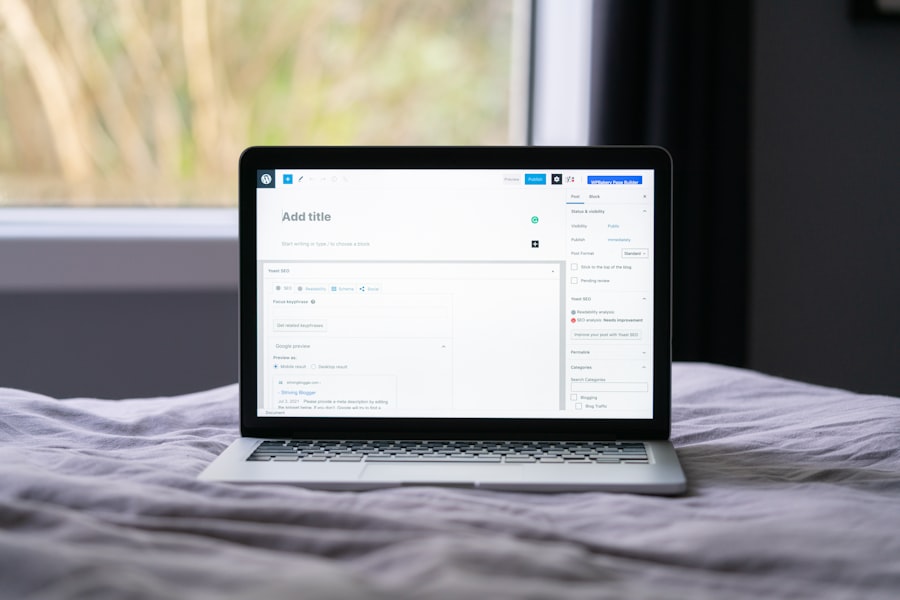Finding my niche has been one of the most pivotal moments in my blogging journey. It’s not just about choosing a topic that I’m passionate about; it’s about identifying a specific area where I can provide unique insights and value. A well-defined niche allows me to stand out in a crowded digital landscape, making it easier for me to connect with an audience that shares my interests.
When I focus on a particular niche, I can tailor my content to meet the needs and preferences of my readers, which ultimately fosters a loyal community around my blog. Moreover, having a niche helps me streamline my content creation process. Instead of feeling overwhelmed by the vast array of topics I could cover, I can concentrate on a specific subject matter that resonates with both me and my audience.
This focus not only enhances the quality of my posts but also establishes me as an authority in that area. As I delve deeper into my niche, I find that I can offer more insightful and valuable content, which in turn attracts more readers and keeps them coming back for more.
Table of Contents
ToggleKey Takeaways
- Finding your niche is crucial for standing out in a crowded online space and attracting a dedicated audience.
- Researching and identifying your target audience helps you tailor your content and marketing efforts to meet their specific needs and interests.
- Choosing the right domain name that reflects your niche and is easy to remember is essential for building a strong online presence.
- Setting up your WordPress blog is a user-friendly and customizable platform that allows you to create and manage your niche blog with ease.
- Selecting a theme and customizing your blog design to align with your niche and brand identity is important for creating a visually appealing and cohesive online presence.
Researching and Identifying Your Target Audience
Once I’ve settled on my niche, the next step is to research and identify my target audience. Understanding who my readers are is crucial for creating content that truly resonates with them. I start by analyzing demographics such as age, gender, location, and interests.
This information helps me paint a clearer picture of who I’m writing for and what their needs might be. Engaging with potential readers through social media platforms or online forums related to my niche can provide invaluable insights into their preferences and pain points. Additionally, I often utilize tools like Google Analytics and social media insights to gather data on my audience’s behavior.
By examining which posts receive the most engagement or which topics spark conversations, I can refine my content strategy to better align with what my audience is looking for. This research phase is not just about numbers; it’s about building a connection with real people who are interested in what I have to say. The more I understand my audience, the more effectively I can communicate with them.
Choosing the Right Domain Name for Your Niche

Selecting the right domain name is a critical step in establishing my blog’s identity. A good domain name should be memorable, relevant to my niche, and easy to spell. When brainstorming ideas, I often think about keywords that reflect the essence of my blog while also considering how they might resonate with my target audience.
A catchy domain name can make a significant difference in attracting visitors and encouraging them to return. I also take into account the importance of keeping it short and simple. Long or complicated domain names can be easily forgotten or misspelled, which could lead potential readers to other sites.
Once I have a few options in mind, I check their availability using domain registration sites. If my first choice isn’t available, I don’t hesitate to get creative with variations or extensions. Ultimately, I want a domain name that not only represents my niche but also feels like a natural fit for me.
Setting Up Your WordPress Blog
| Step | Description |
|---|---|
| 1 | Choose a domain name and hosting provider |
| 2 | Install WordPress on your hosting server |
| 3 | Select and customize a WordPress theme |
| 4 | Install essential plugins for security and SEO |
| 5 | Create important pages such as About, Contact, and Privacy Policy |
| 6 | Set up categories and tags for organizing your content |
| 7 | Configure permalinks for better URL structure |
With my domain name secured, it’s time to set up my WordPress blog. The process is relatively straightforward, especially with the plethora of resources available online. First, I choose a reliable hosting provider that meets my needs in terms of speed, security, and customer support.
Once I’ve selected a plan and installed WordPress, I can begin customizing my blog to reflect my unique style and brand. During the setup process, I pay close attention to essential settings such as permalinks, privacy options, and user roles. These foundational elements are crucial for ensuring that my blog runs smoothly and is optimized for search engines.
Additionally, I take the time to create essential pages like “About” and “Contact,” as these help establish credibility and facilitate communication with my audience. Setting up my blog is an exciting step that brings me closer to sharing my passion with the world.
Selecting a Theme and Customizing Your Blog Design
Choosing the right theme for my WordPress blog is another important aspect of creating an appealing online presence. A well-designed theme not only enhances the visual appeal of my site but also improves user experience. When browsing through various themes, I look for one that aligns with my niche and reflects the tone of my content.
Whether it’s a clean and minimalist design or something more vibrant and dynamic, the theme should resonate with both me and my target audience. Once I’ve selected a theme, I dive into customization options to make it truly mine. This includes adjusting colors, fonts, and layouts to create a cohesive look that represents my brand identity.
I also ensure that my blog is mobile-responsive since many readers access content on their smartphones or tablets. By investing time in customizing my blog design, I create an inviting space where visitors feel comfortable exploring my content.
Creating Compelling Content for Your Niche

Content creation is at the heart of blogging, and crafting compelling posts is essential for engaging my audience. To do this effectively, I focus on providing valuable information that addresses the needs and interests of my readers. Whether it’s how-to guides, personal stories, or expert interviews, each piece of content should offer something meaningful.
I often brainstorm ideas based on trending topics within my niche or questions that arise from interactions with my audience. In addition to being informative, I strive to make my writing relatable and engaging. Using storytelling techniques helps me connect with readers on a personal level, making them more likely to share my posts or leave comments.
I also pay attention to formatting; breaking up text with headings, bullet points, and images makes it easier for readers to digest information. By consistently producing high-quality content, I build trust with my audience and encourage them to return for more.
Utilizing Plugins to Enhance Your Blog’s Functionality
One of the great advantages of using WordPress is the vast array of plugins available to enhance my blog’s functionality. These tools can help me optimize various aspects of my site, from improving SEO to enhancing user experience. For instance, I often use plugins like Yoast SEO to ensure that my posts are optimized for search engines, helping me attract more organic traffic over time.
In addition to SEO plugins, there are also tools for social media integration, email marketing, and analytics tracking that can significantly improve how I manage my blog. By carefully selecting plugins that align with my goals, I can streamline processes and focus more on creating content rather than getting bogged down by technical details. However, I remain mindful not to overload my site with too many plugins; this can slow down performance and create conflicts.
Implementing SEO Strategies to Attract Your Target Audience
Search engine optimization (SEO) is crucial for driving traffic to my blog and reaching a wider audience within my niche. To implement effective SEO strategies, I start by conducting keyword research to identify terms that potential readers are searching for related to my content. By incorporating these keywords naturally into my posts—especially in titles, headings, and meta descriptions—I increase the likelihood of ranking higher in search engine results.
In addition to keyword optimization, I focus on creating high-quality backlinks by collaborating with other bloggers or contributing guest posts on reputable sites within my niche. This not only boosts my credibility but also drives referral traffic back to my blog. Regularly updating old posts with fresh information and optimizing images for faster loading times are other strategies I employ to enhance SEO performance over time.
Engaging with Your Niche Community
Building a community around my blog is essential for fostering engagement and loyalty among readers. To achieve this, I actively participate in discussions within online forums or social media groups related to my niche. By sharing insights and answering questions, I position myself as a knowledgeable resource while also connecting with potential readers who may be interested in my content.
I also encourage interaction on my blog by inviting comments on posts and responding promptly to feedback or questions from readers. Hosting giveaways or challenges related to my niche can further engage the community and create excitement around my content. By nurturing these relationships, I cultivate a sense of belonging among readers who feel valued and connected to both me and each other.
Monetizing Your Niche Blog
As my blog grows in popularity, exploring monetization options becomes an exciting prospect. There are various avenues available for generating income from a niche blog, including affiliate marketing, sponsored posts, and selling digital products or services related to my expertise. Affiliate marketing has been particularly appealing; by promoting products that align with my niche and providing honest reviews or recommendations, I can earn commissions on sales generated through my links.
Additionally, creating digital products such as e-books or online courses allows me to share valuable knowledge while generating revenue. Sponsored posts can also be lucrative; collaborating with brands that resonate with my audience enables me to maintain authenticity while earning income from partnerships. As I navigate these monetization strategies, I remain committed to providing value to my readers without compromising the integrity of my content.
Analyzing and Adjusting Your Niche Strategy for Growth
Finally, continuous analysis of my blogging strategy is vital for long-term growth and success within my niche. By regularly reviewing analytics data—such as traffic sources, popular posts, and audience demographics—I gain insights into what’s working well and what areas may need improvement. This data-driven approach allows me to make informed decisions about future content topics or promotional strategies.
I also stay attuned to trends within my niche by following industry news or engaging with other bloggers in similar fields.
Adapting to changes in audience preferences or emerging topics ensures that I remain relevant and continue providing valuable content over time.
By being flexible and open to adjustments in my strategy, I position myself for sustained growth while nurturing a thriving community around my blog.
In conclusion, finding success in blogging requires dedication and strategic planning at every stage—from identifying a niche to engaging with an audience and monetizing content effectively. By following these steps diligently while remaining true to myself and passionate about what I do, I can create a fulfilling blogging experience that resonates with others while achieving personal goals along the way.
When embarking on the journey to find your niche and build a WordPress blog around it, it’s crucial to equip yourself with the right tools and knowledge to ensure your blog stands out. A related article that can provide valuable insights is Mastering WordPress Development: Essential Tips and Tricks. This article offers a comprehensive guide on enhancing your WordPress skills, which is essential for creating a blog that not only captures your niche but also engages your audience effectively. By mastering these development techniques, you can ensure your blog is both functional and visually appealing, setting a strong foundation for your niche-focused content.
FAQs
What is a niche?
A niche is a specific area of interest or expertise within a larger market or industry. It is a specialized segment of the market for a particular kind of product or service.
Why is it important to find a niche for your WordPress blog?
Finding a niche for your WordPress blog is important because it helps you target a specific audience, stand out from the competition, and establish yourself as an authority in a particular area. It also makes it easier to create content and attract a dedicated following.
How can I find my niche for a WordPress blog?
To find your niche for a WordPress blog, you can start by identifying your passions, interests, and expertise. You can also research popular topics and trends within your industry, and consider the needs and problems of your target audience.
What are some tips for building a WordPress blog around a niche?
Some tips for building a WordPress blog around a niche include choosing a relevant domain name, selecting a suitable WordPress theme, creating high-quality content that resonates with your target audience, and engaging with your readers through comments and social media.
How can I monetize a WordPress blog within a niche?
You can monetize a WordPress blog within a niche by offering products or services related to your niche, joining affiliate programs, displaying advertisements, and creating sponsored content. You can also consider offering premium content or memberships.




